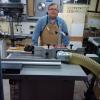The folks on this forum recently let me know that for some jobs, no amount of perceptible error is acceptable. I was trying to glue six pieces of walnut together to make a solid guitar body, and they told me a 0.002" gap was no good. I've also learned that snipe which is too small to show up on a dial caliper will light up beautifully when you take sandpaper to it.
The more woodworking I do, the more I appreciate my milling machine. I'm trying to put some inlays (structural, not thin decorative stuff) into the front of my guitar body, and I've found that the mill gives faultless measurements, straight edges, and perfect roundovers with very little effort.
I'm amazed at how precise my table saw can be. If I weren't so lazy, I'm sure I could get precision of a thousandth or less by ginning up an adjustment rig with a dial indicator on it. And it edge-joints perfectly, with a simple jig someone here suggested.
Mark Duginske has a funny part in his woodworking machines video, in which he ridicules people who blow wads of cash on "precision" doodads that get you within 1/32". He holds up a bunch of Post-its (his shims) and notes that each one is about 1/8 of 1/32" thick. Personally, I like doodads, because they are useful to people like me who have no skills, but I think he demonstrates more wisdom than I do.
Machinists use rolling papers to do even better. If you put one between a cutter and a surface and bring the cutter just close enough to make the paper tear when you pull on it, you're within a thousandth.
Cry "Havoc," and let slip the dogs of bench.
I was socially distant before it was cool.
A little authority corrupts a lot.






 Reply With Quote
Reply With Quote







